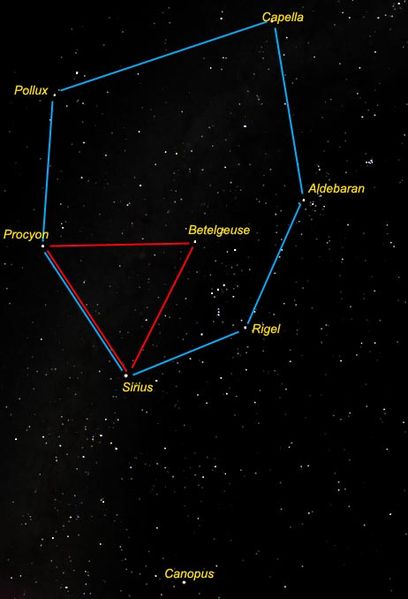
These next several evenings – March 13, 14 and 15, 2019, the waxing moon is moving inside the Winter Circle, sometimes called the Winter Hexagon. It’s a large circular (hexagonal) star asterism – not one of the 88 official constellations, but just a noticeable pattern of stars – consisting of six 1st-magnitude stars in six separate constellations:
Capella – brightest star in the constellation Auriga the Charioteer
Pollux – brightest star in the constellation Gemini the Twins
Castor – second-brightest star in the constellation Gemini the Twins
Procyon – brightest star in the the constellation Canis Minor the Lesser Dog
Sirius – brightest star in the constellation Canis Major the Great Dog
Rigel – brightest star in the constellation Orion the Hunter
Aldebaran – brightest star in the constellation Taurus the Bull
Technically speaking, Castor is a 2nd-magnitude star, though it’s the brightest of all the 2nd-magnitude stars in the sky. Near the center of the Circle, you’ll find center Orion’s bright red star Betelgeuse.
Here are constellation charts via the International Astronomical Union (IAU)
The Winter Circle (or Hexagon) contains another pattern known as the Winter Triangle. Image via SouledOut.org.
In the evening in March, we in the Northern Hemisphere see the Winter Circle fill up much of our southern sky at nightfall. Elsewhere in the world – even in places where it’s not winter – the moon will also be in the midst of these stars. Meanwhile, as seen from temperate latitudes in the Southern Hemisphere, what we northerners call the Winter Circle will appear upside-down relative to our northern view. That is, southern sky watchers will see the star Sirius at top and the star Capella at bottom.
No chart can adequately convey the Winter Circle’s humongous size! It dwarfs the constellation Orion the Hunter, which is a rather large constellation, occupying the southwestern part of the Winter Circle pattern.
By the way, the moon is now showing you where the sun resides (more or less) in front of the backdrop stars in the month of June. So enjoy the Winter Circle. And contemplate the sun being in this part of the sky when summer returns to the Northern Hemisphere!

The Winter Circle, or Hexagon, is marked in blue. The Winter Triangle is marked in red. Image via Wikimedia Commons.
Bottom line: On March 13, 14 1nd 15, 2019, the moon resides inside the Winter Circle, a large asterism made of seven brilliant stars.
Read more: Winter Circle, or Hexagon, made of bright stars
EarthSky astronomy kits are perfect for beginners. Order today from the EarthSky store
Donate: Your support means the world to us
from EarthSky https://ift.tt/2Hrrdca

These next several evenings – March 13, 14 and 15, 2019, the waxing moon is moving inside the Winter Circle, sometimes called the Winter Hexagon. It’s a large circular (hexagonal) star asterism – not one of the 88 official constellations, but just a noticeable pattern of stars – consisting of six 1st-magnitude stars in six separate constellations:
Capella – brightest star in the constellation Auriga the Charioteer
Pollux – brightest star in the constellation Gemini the Twins
Castor – second-brightest star in the constellation Gemini the Twins
Procyon – brightest star in the the constellation Canis Minor the Lesser Dog
Sirius – brightest star in the constellation Canis Major the Great Dog
Rigel – brightest star in the constellation Orion the Hunter
Aldebaran – brightest star in the constellation Taurus the Bull
Technically speaking, Castor is a 2nd-magnitude star, though it’s the brightest of all the 2nd-magnitude stars in the sky. Near the center of the Circle, you’ll find center Orion’s bright red star Betelgeuse.
Here are constellation charts via the International Astronomical Union (IAU)
The Winter Circle (or Hexagon) contains another pattern known as the Winter Triangle. Image via SouledOut.org.
In the evening in March, we in the Northern Hemisphere see the Winter Circle fill up much of our southern sky at nightfall. Elsewhere in the world – even in places where it’s not winter – the moon will also be in the midst of these stars. Meanwhile, as seen from temperate latitudes in the Southern Hemisphere, what we northerners call the Winter Circle will appear upside-down relative to our northern view. That is, southern sky watchers will see the star Sirius at top and the star Capella at bottom.
No chart can adequately convey the Winter Circle’s humongous size! It dwarfs the constellation Orion the Hunter, which is a rather large constellation, occupying the southwestern part of the Winter Circle pattern.
By the way, the moon is now showing you where the sun resides (more or less) in front of the backdrop stars in the month of June. So enjoy the Winter Circle. And contemplate the sun being in this part of the sky when summer returns to the Northern Hemisphere!

The Winter Circle, or Hexagon, is marked in blue. The Winter Triangle is marked in red. Image via Wikimedia Commons.
Bottom line: On March 13, 14 1nd 15, 2019, the moon resides inside the Winter Circle, a large asterism made of seven brilliant stars.
Read more: Winter Circle, or Hexagon, made of bright stars
EarthSky astronomy kits are perfect for beginners. Order today from the EarthSky store
Donate: Your support means the world to us
from EarthSky https://ift.tt/2Hrrdca

Aucun commentaire:
Enregistrer un commentaire